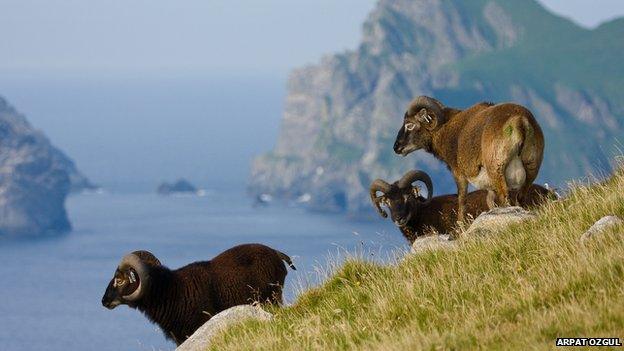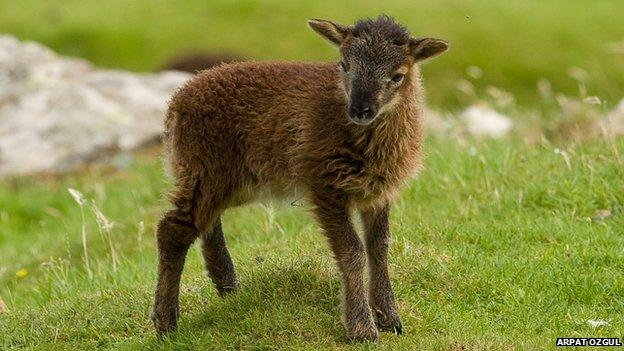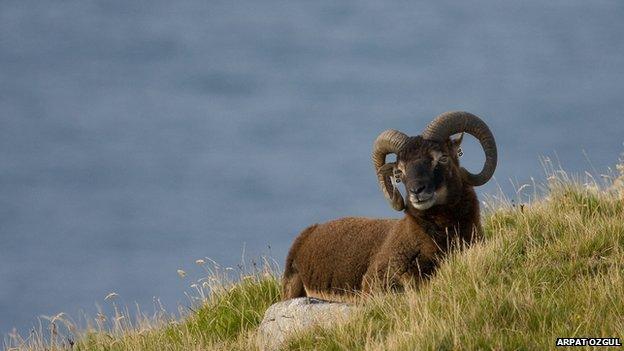St Kilda Soay sheep study reaches 30th anniversary
- Published

Soay sheep on St Kilda
Scientists are celebrating the 30th anniversary of a unique research project which studies wild sheep living in the remote archipelago of St Kilda.
Their work is focussed on the feral population of Soay sheep on Hirta.
Edinburgh University says the study has enabled ground-breaking discoveries about how Charles Darwin's theory of natural selection plays out in reality.
It has also given insights into how wild animals age and how they are responding to climate change.
Researchers from the University of Edinburgh, the University of Cambridge and Imperial College London have been marking the anniversary at a series of lectures held at the Royal Society of Edinburgh.
Alexander Bennett of the National Trust for Scotland, which was bequeathed St Kilda by the 5th Marquess of Bute in 1957, describes the Soay sheep as emblematic of the islands.
He said: "They've become wild since the islanders themselves were evacuated in 1930 and today the visitors love them.
"But we have to explain to them the importance of this research - the longest running large mammal research project in the world."

Scientists have been intrigued by the way in which the number of Soay sheep on Hirta increases, before falling sharply. This process is repeated at irregular intervals.
Prof Josephine Pemberton of the University of Edinburgh's School of Biological Sciences has been involved in the study since 1985.
She told BBC Scotland News: "The sheep are relatively straightforward to study because they are in a very simple ecosystem.
"They have no competitors for the food and there are no predators.
"You can follow the lives of individuals and in that way you can track what individual events lead them to have these very unusual population dynamics."
High numbers, poor winter weather and demographics all increase the likelihood of a crash in numbers.
A sharp drop in the population is less likely when there are relatively high numbers of mature females - the most resilient group of Soay sheep.
Visitors who have made the long journey to St Kilda often ask why the Soay sheep are much smaller than domestic sheep seen elsewhere.
The scientists believe they have the answer.

Prof Pemberton explained: "They are growing a little more slowly compared with 30 years ago.
"Although we know that small lambs are more likely to die in winter, what's been happening is that as the climate has changed and the winters have got shorter, the little lambs are more likely to survive.
"The consequence of that is that you have these very small animals entering the population and they are bringing down the mean size."
Internationally important
Dan Nussey, a research fellow at the University of Edinburgh, studies the ageing process in wild animals.
He said: "I am interested in establishing what is responsible for the variation that we see in when and how quickly ageing manifests in the Soay sheep and more generally in animal populations.
"There is a very long standing belief in the more mainstream ageing research world that wild animals don't grow old, essentially that nature is too harsh and they don't live long enough.
"What we've seen over the last five to 10 years with the emergence and maturation of long term studies, like the one in St Kilda, is overwhelming evidence that particularly in longer lived birds and mammals we really can see that process."
The research work in St Kilda is seen as internationally important.
Few other populations of large mammals anywhere in the world are studied in such detail.
Similar research is focussed on red deer on the Hebridean island of Rum, bighorn sheep in Canada and kangaroos in Australia.
But after decades of work, the Soay sheep of St Kilda continue to fascinate scientists from around the world who travel to these remote islands to learn more about this unique population and our natural world.